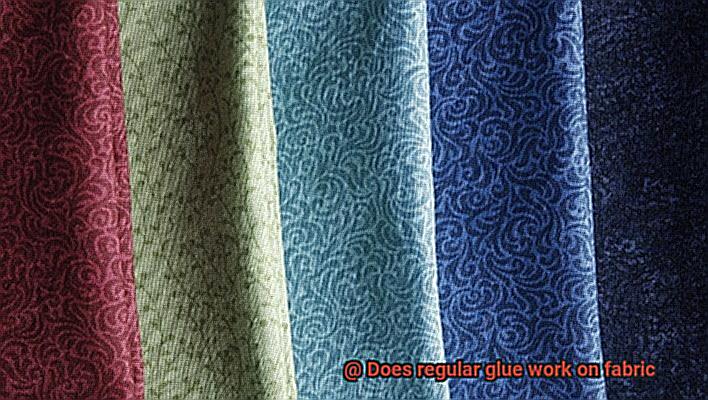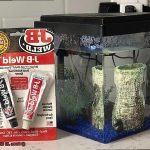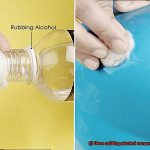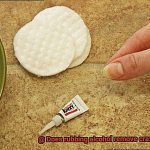Are you tired of your fabric projects falling apart? Do you feel like you’re drowning in a sea of adhesives, unsure which one will work best for your project? Fear not, my friend. We’ve all been there. But the million-dollar question remains: does regular glue work on fabric?
It’s a seemingly simple question, but the answer is anything but straightforward. With so many different types of glues and fabrics out there, finding the right adhesive can feel like a daunting task. You don’t want to end up with a sticky mess or worse, damage your precious fabric.
In this blog post, we’ll dive deep into the world of fabric gluing and explore whether regular glue is up to the task. We’ll take a look at various types of adhesives – from school glue to fabric adhesive spray – and assess which ones are best suited for different projects.
But that’s not all. We’ll also examine the pros and cons of using regular glue on fabric and offer some tips and tricks to ensure your project is a success. Whether you’re a seasoned crafter or just starting out, this post has got you covered.
So grab yourself a cuppa, sit back and relax as we unravel the mysteries of fabric gluing together. By the end of this post, you’ll be armed with all the knowledge you need to choose the right adhesive for your next project.
Types of Glue
Contents
- 1 Types of Glue
- 1.1 Fabric Glue
- 1.2 When using fabric glue, it’s important to keep in mind that it may require a longer drying time than other types of glue. Be sure to follow the instructions carefully and allow enough time for the glue to dry completely before handling your project.
- 1.3 White Glue
- 1.4 Super Glue
- 1.5 Hot Glue
- 1.6 Spray Adhesive
- 2 Types of Fabric
- 3 Temporary vs Permanent Bonds
- 4 Pre-Treatment for Fabrics
- 5 Pros and Cons of Regular Glue on Fabric
- 6 Best Practices for Using Regular Glue on Fabric
- 7 Alternatives to Regular Glue on Fabric
- 8 Common Mistakes when Using Regular Glue on Fabric
- 9 Conclusion
As a crafter, you know that bonding fabric pieces together can be a challenging task. It requires the right kind of glue that can hold up the weight of the fabric and allow for movement without breaking apart. Luckily, there are various types of glue available that cater to different needs. Here are 5 sub-sections on the different types of glues that work well with fabric.
Fabric Glue
Fabric glue is specifically designed for use with fabric. It is made from a water-based adhesive that dries clear and flexible, making it ideal for use on a variety of fabrics. This type of glue is perfect for attaching embellishments, hemming pants, or repairing tears in clothing. It is also great for creating no-sew projects such as appliques or patches.
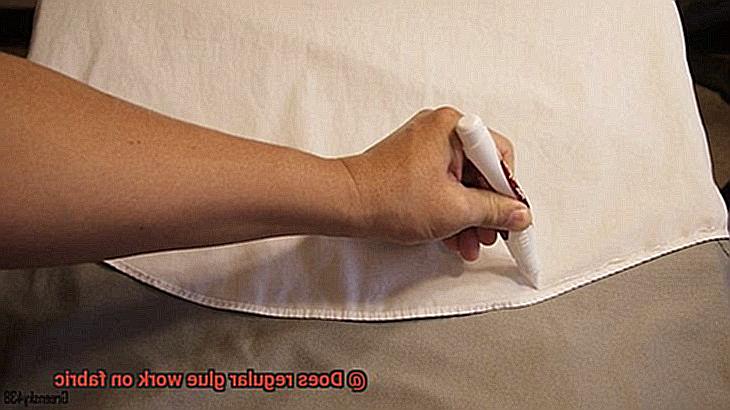
When using fabric glue, it’s important to keep in mind that it may require a longer drying time than other types of glue. Be sure to follow the instructions carefully and allow enough time for the glue to dry completely before handling your project.
White Glue
White glue, also known as school glue or PVA glue, can be used on fabric but may not be the best choice for all projects. This type of glue dries clear and is easy to clean up with water, making it great for paper crafts and other non-fabric projects.
However, white glue may not hold up well on heavier fabrics like denim or wool. It’s best to test a small area first before using it on your entire project.
Super Glue
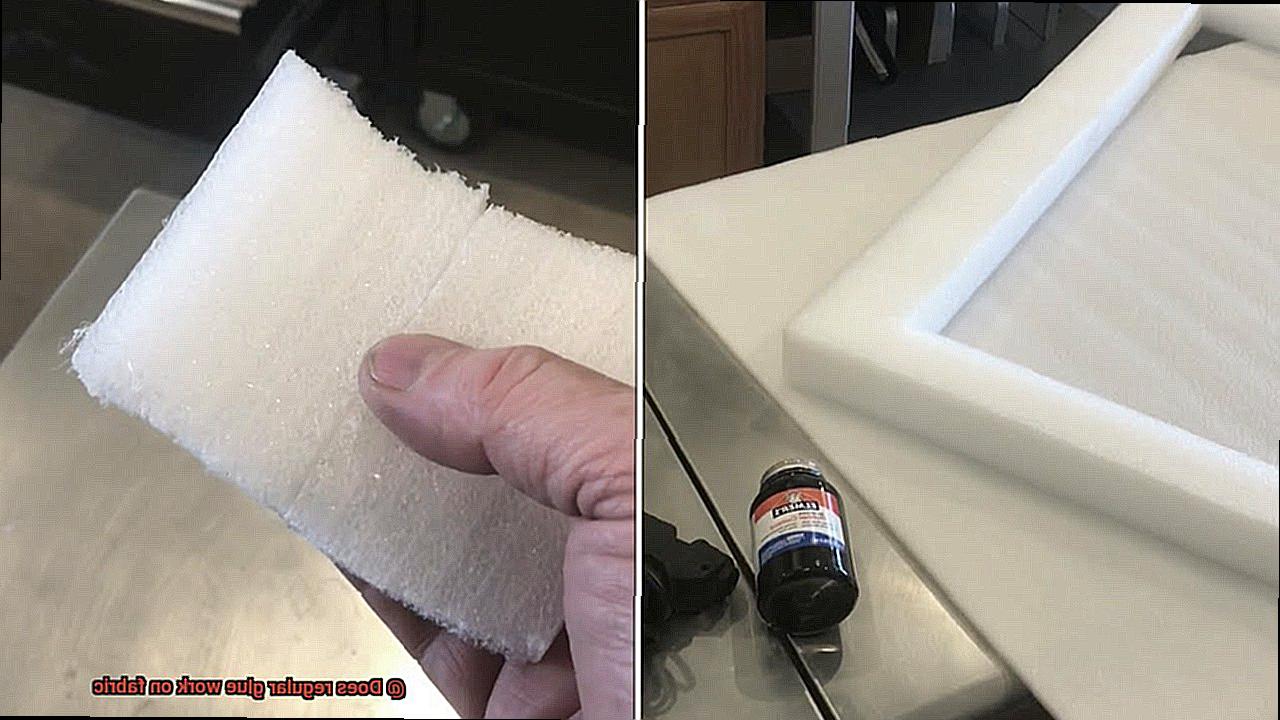
Superglue or cyanoacrylate glue is a fast-drying adhesive that creates a strong bond between two surfaces. It can be used on fabric but may not be the best choice for all projects.
While superglue can work well for small repairs, it can create a stiff bond that may not be flexible enough for certain fabrics. It’s essential to use superglue with caution when working with delicate fabrics.
Hot Glue
Hot glue is a popular choice for crafting and can be used on fabric. It is applied using a hot glue gun and creates a strong bond quickly. However, hot glue can be messy and may not be the best choice for delicate fabrics or projects that require flexibility.
When using hot glue, make sure to apply it carefully and avoid getting it on your skin or clothing. It’s also important to keep in mind that hot glue may melt or damage certain types of fabrics.
Spray Adhesive
Spray adhesive is a versatile adhesive that can be used on fabric, paper, and other materials. It creates a temporary bond that can easily be removed or repositioned, making it great for creating patterns or templates for sewing projects.
One advantage of spray adhesive is that it doesn’t leave a residue like other types of glue.
Types of Fabric
The importance of glue in crafting, sewing, and fixing clothing cannot be overstated. But did you know that not all fabrics react the same way to regular glue? It is essential to understand the differences between fabric types and their unique properties before applying any adhesive to them. Let’s explore these differences and how they may affect the use of regular glue.
Understanding Different Types of Fabrics
Fabrics come in different types, each with its own unique properties. Some delicate fabrics such as cotton, linen, and silk require specific handling while others like nylon and polyester can withstand harsh treatments. Knowing the type of fabric you’re working with is crucial before attempting to use any adhesive.
Porosity and Absorbency
Regular glue may adhere differently to different fabrics based on their porosity and absorbency. For instance, cotton and linen are generally more porous and absorbent than synthetic fabrics like polyester or nylon. This difference in porosity may make it easier for glue to stick to cotton or linen but challenging for it to adhere to synthetic fabrics.
Weight and Texture
The weight and texture of a fabric can also affect how well regular glue will hold up. Heavy fabrics like denim or canvas may require a stronger adhesive than lighter materials like silk or chiffon. Choosing the right adhesive based on weight and texture is crucial to achieving a strong bond.
Special Care Instructions
Some fabrics may have special care instructions that need to be followed before applying any type of adhesive. Silk, for example, is a delicate fabric that requires special attention when handling. Using a specialized fabric glue is recommended for silk as regular glue can damage the material.
Temporary vs Permanent Bond
Consider what type of bond you need for your project before deciding on which type of adhesive to use. If you need a temporary hold, then regular glue may suffice. But if you need a stronger, more permanent bond, then a specialized fabric glue may be necessary.
Pre-Treatment
Certain fabrics may require pre-treatment before gluing, such as pre-washing or using a fabric stabilizer. Failure to do so may result in the glue not adhering correctly or damaging the fabric. Pre-treatment is an essential step in ensuring that the adhesive bonds well with the fabric.
Temporary vs Permanent Bonds
When working with fabric, the decision between a temporary or permanent bond can make all the difference.
Let’s start with temporary bonds, which are ideal for quick fixes or projects that don’t require a long-lasting hold. You can create a temporary bond using a variety of adhesives such as fabric glue, spray adhesive, or tape. Need to hem some pants or attach an embellishment to clothing? A temporary bond will do the trick. However, keep in mind that these types of bonds may not hold up well over time and may need to be re-applied periodically.
In contrast, permanent bonds require a stronger adhesive like industrial strength fabric glue or epoxy. These types of adhesives form a permanent bond that can withstand wear and tear over time. If you’re repairing tears in clothing or creating custom garments, a permanent bond is necessary.
It’s vital to choose an adhesive specifically designed for fabric since regular glues may not work as well and could damage the material. Fabric adhesives are formulated to work with the unique properties of fabric fibers, providing a stronger and longer-lasting bond.
When choosing between temporary and permanent bonds, it’s essential to consider the nature of your project. Here are some sub-topics to consider:
Temporary bonds:
- Ideal for quick fixes or projects that don’t require a long-lasting hold
- Can be created using various adhesives such as fabric glue, spray adhesive, or tape
- Perfect for hemming pants or attaching embellishments to clothing
- May need to be re-applied periodically
- Require a stronger adhesive like industrial strength fabric glue or epoxy
- Form a permanent bond that can withstand wear and tear over time
- Necessary for repairing tears in clothing or creating custom garments
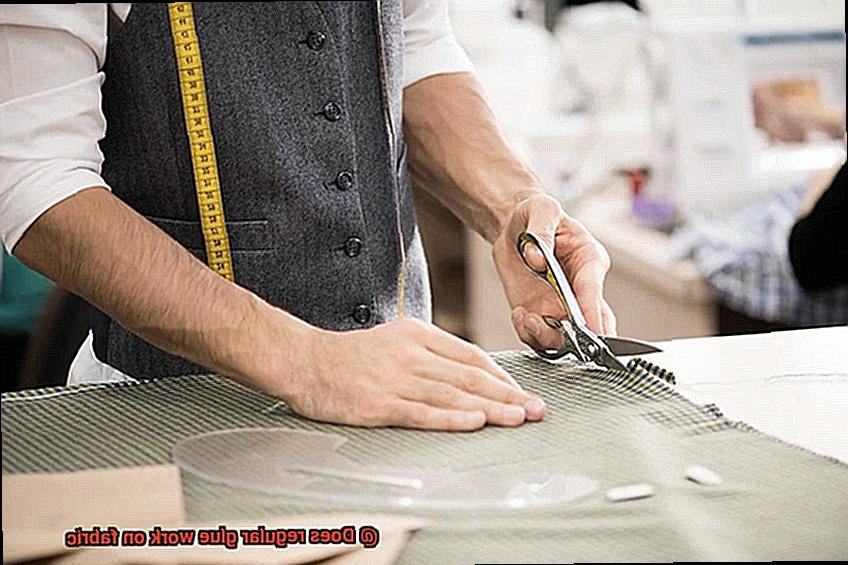
Permanent bonds:
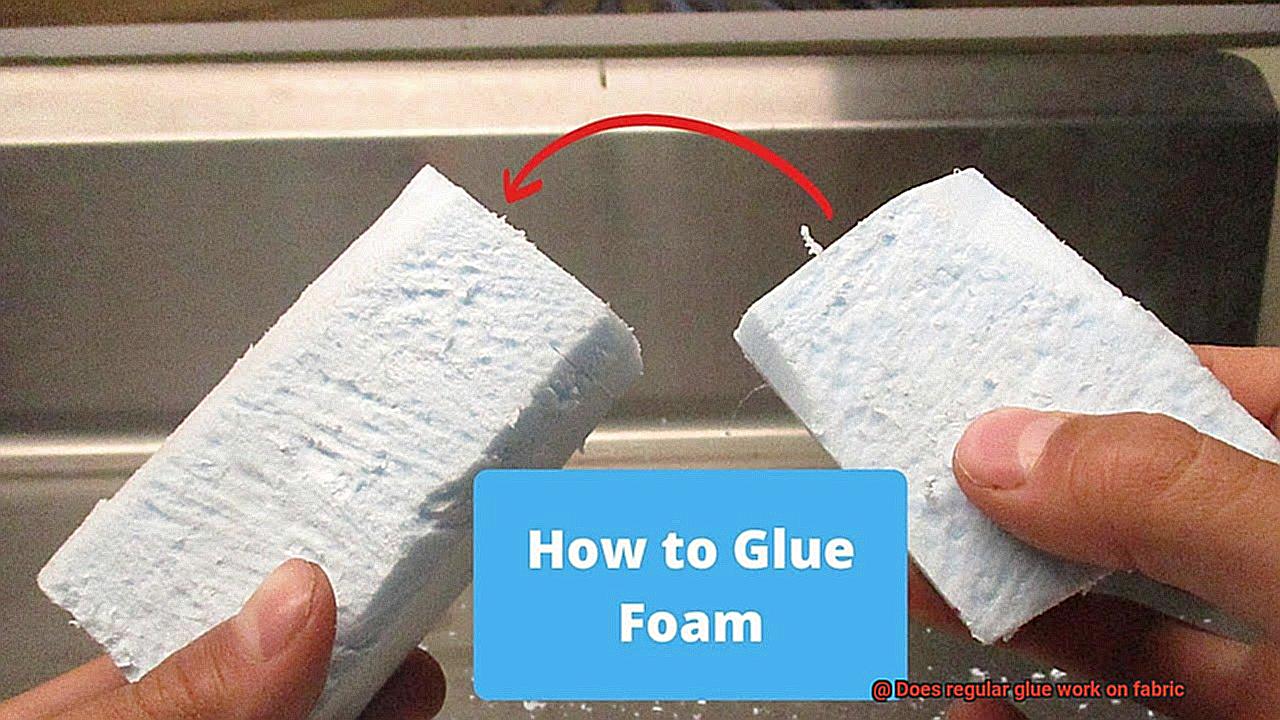
Pre-Treatment for Fabrics
Then, you know that pre-treatment for fabrics is the foundation of a successful project. As an expert in this field, I’m here to share with you the importance of pre-treating fabrics before gluing and all the techniques involved.
Why is pre-treatment so critical? Gluing fabrics requires a strong bond that lasts over time. Any dirt, dust, or oils on the fabric surface can interfere with the glue’s bonding ability, leading to failure. Pre-treatment helps prepare the fabric surface by removing any contaminants and ensuring a clean surface for the glue to adhere to.
Let’s explore some pre-treatment techniques. Washing the fabric with soap and water is a common method that removes surface dirt and grime. Rubbing alcohol or vinegar can also be used for a thorough cleaning. However, it is crucial to test them on a small, inconspicuous area first to avoid damaging or discoloring the fabric.
Certain fabrics require special pre-treatment procedures before gluing. For example, delicate or porous fabrics such as silk or wool may need a stabilizer or interfacing to prevent damage while applying glue. Fabrics treated with stain-resistant or water-repellent coatings may need sanding or roughing up to ensure proper adhesion.
In summary, pre-treatment for fabrics is vital for bonding success. By removing any contaminants and preparing the fabric surface correctly, you can ensure that your glue adheres properly and provides a long-lasting bond. Follow specific pre-treatment instructions for each type of fabric to avoid any damage or failure of the adhesive bond.
Pros and Cons of Regular Glue on Fabric
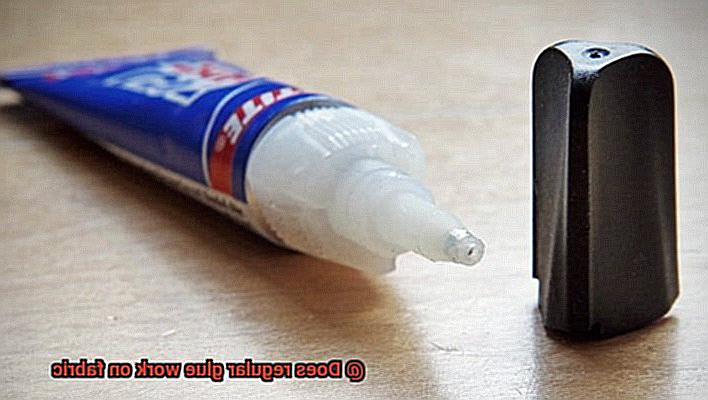
Although it can be used for certain purposes, it’s important to weigh the pros and cons before deciding whether to use it.
Starting with the advantages, regular glue is cost-effective. If you’re working on a budget or have a small-scale project, regular glue is an excellent option. It’s significantly cheaper than specialized fabric glue or other adhesives. Secondly, regular glue is widely available. You can easily find it at any craft store, office supply store, or even your local supermarket. Lastly, when applied correctly, regular glue dries clear, making it an ideal option for light-colored fabrics.
On the flip side, there are some drawbacks to using regular glue on fabric. Firstly, regular glue isn’t as durable as fabric glue. It may not hold up well under stress or repeated washing. Therefore, if you’re working on a project that will be exposed to wear and tear, it’s best to choose a stronger adhesive. Secondly, regular glue can stiffen fabric when applied. If you need your fabric to remain flexible, exercise caution when applying regular glue. Lastly, regular glue may leave residue on your fabric if not applied correctly or if too much is used.
Best Practices for Using Regular Glue on Fabric
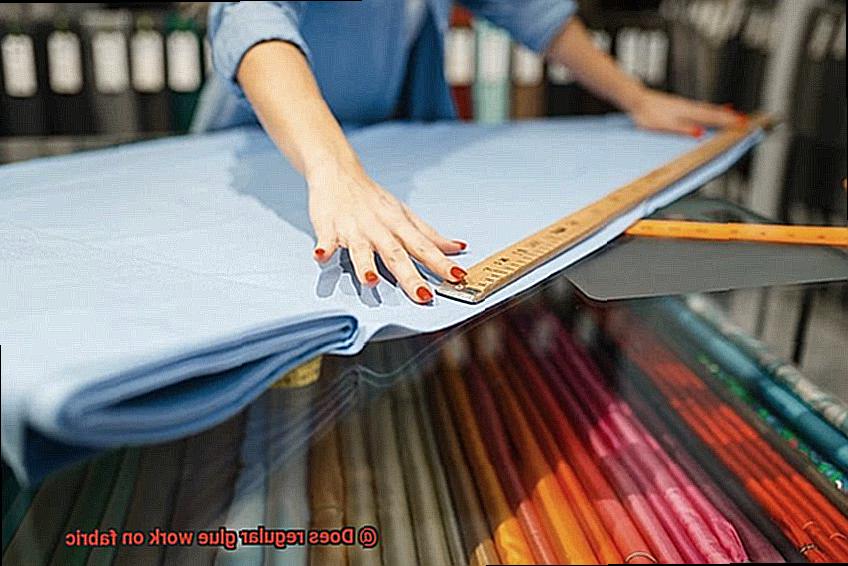
As an expert, I have compiled some best practices to ensure your project stays intact.
First and foremost, make sure you use the right type of glue. Clear drying fabric glue is your best option as it’s specially designed for use on textiles. This will guarantee a strong bond that won’t wear out over time.
Before gluing, prep the fabric by cleaning it thoroughly. Any dirt or debris can hinder the bonding process. It’s also crucial to prewash the fabric to remove any sizing or chemicals that could prevent the glue from adhering properly.
When applying the glue, remember less is more. A thin layer spread evenly over the surface is key. Overdoing it can cause the fabric to become stiff and brittle, leading to cracking or tearing over time. Additionally, apply pressure to the glued area, using a heavy book or iron with a pressing cloth, ensuring a robust bond.
Lastly, always follow the manufacturer’s instructions for drying times and washing instructions. Some glues may require specific washing and drying settings or temperatures, so read the label carefully before using.
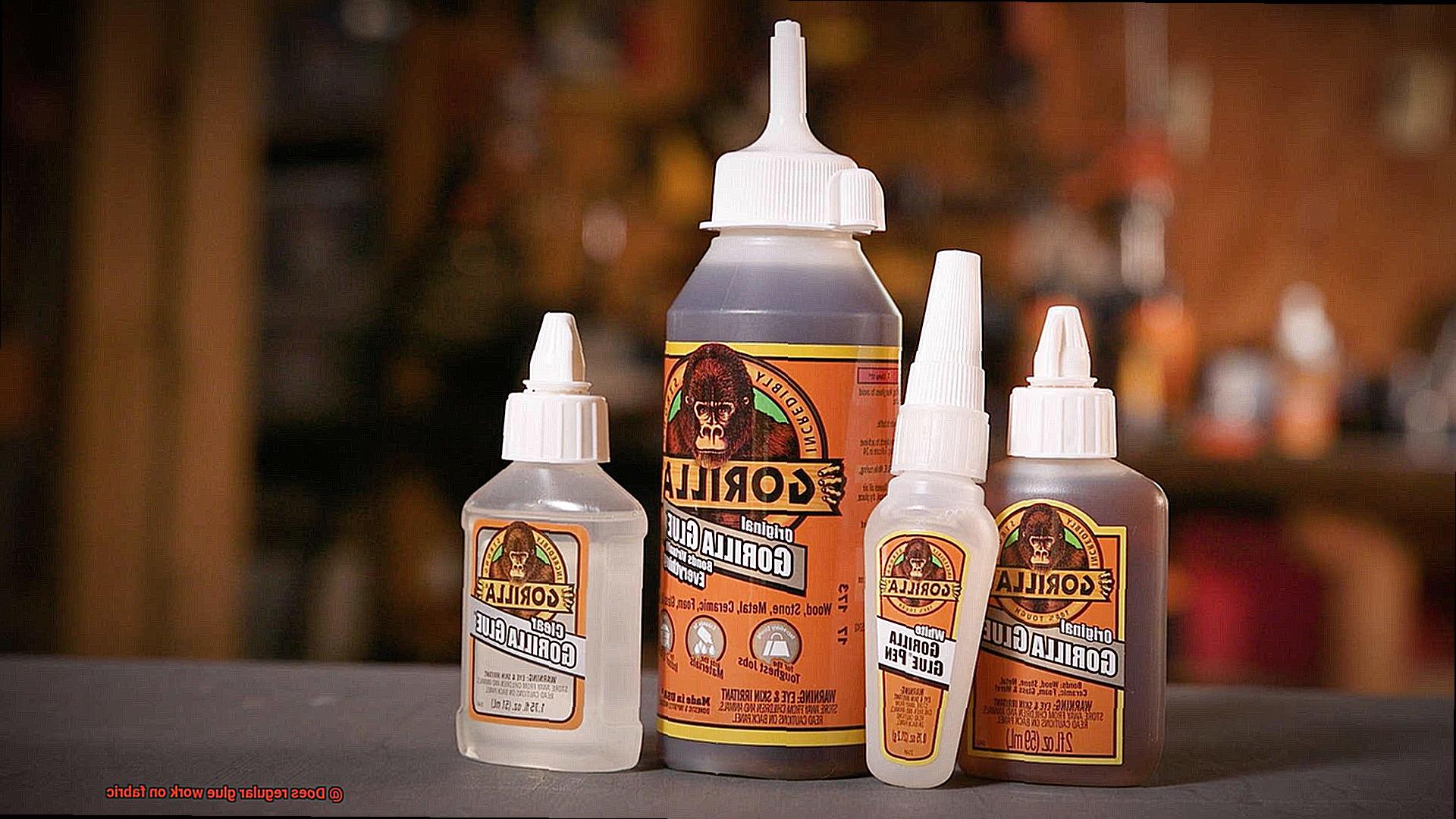
Alternatives to Regular Glue on Fabric
As an expert in this area, I have researched and compiled a list of alternatives to regular glue on fabric that you can try out for your next project.
First on the list is fusible webbing, a type of adhesive material that is activated by heat and pressure. This option provides a strong bond without the mess and potential damage caused by liquid glue. It’s perfect for various fabric projects, including hemming pants and creating appliques. The process is simple; all you need to do is apply the fusible webbing to one side of the fabric, place the other piece of fabric on top, and iron them together.
Another great alternative is fabric glue specifically designed for use on textiles. These glues are formulated to be flexible and durable, making them ideal for fabrics that will be washed or stretched. They come in a variety of formulas, including washable and non-washable options, and can be applied with a brush or nozzle. Fabric glue is perfect for those who want to avoid sewing or ironing their fabrics together.
If you’re willing to put in some extra time and skill, sewing can also provide a stronger and longer-lasting bond between fabrics. Hand-stitching and machine-sewing are both viable options depending on the project at hand. Sewing can be used to attach two pieces of fabric or add decorative stitches to enhance the design.
For those who like to experiment with unconventional methods, some crafters swear by using natural adhesives such as egg whites or milk to attach fabric. While these methods may seem odd, they have been used for centuries and can provide a surprisingly strong and durable bond. However, it’s important to note that these natural adhesives may not be suitable for all types of fabrics.
Common Mistakes when Using Regular Glue on Fabric
Here are some of the most common mistakes people make when using regular glue on fabric and how to avoid them.
Firstly, people often make the mistake of using too much glue. Remember, a little goes a long way. Using too much glue can lead to a messy and uneven application that can ruin your project. So, use just enough glue to get the job done and avoid any unnecessary mess.
Another mistake is not prepping your fabric properly before applying the glue. Make sure your fabric is clean and free of any dirt or debris, as well as completely dry before adding the glue. If you skip this step, the glue may not adhere properly to the fabric and result in a weak bond.
Using the wrong type of glue is another common mistake. Regular glues such as school glue or white glue may not be strong enough to hold certain fabrics together. It’s important to use a fabric glue that’s specifically designed for use on fabric, as it will provide a stronger hold and prevent fraying or coming apart.
Lastly, not allowing enough time for the glue to dry is another mistake that people often make. It’s important to follow the manufacturer’s instructions and allow enough time for the glue to fully dry before handling or wearing the fabric. Rushing this process can result in the glue not being fully set, which can lead to damage or separation.
mORL1jJSdlk” >
Conclusion
To sum up, the question of whether regular glue is suitable for fabric projects is a nuanced one. With so many types of glues and fabrics available, it’s crucial to consider each material’s properties before selecting an adhesive.
While regular glue may work for some projects, it may not be the best option for others. Factors like weight, texture, porosity, and absorbency can all impact the effectiveness of the adhesive.
If you’re looking for a strong and durable bond specifically designed for textiles, fabric glue is your best bet. However, fusible webbing or sewing can also provide reliable results.
When using regular glue on fabric, proper preparation is key. Be sure to clean the fabric thoroughly and allow ample drying time before applying the adhesive. Overusing glue or choosing the wrong type can lead to weak bonds or even damage to your project.

